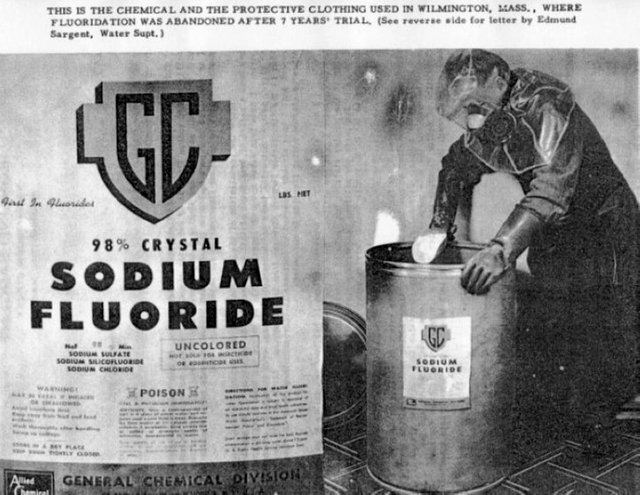ADA Untroubled By Yet Another Study Pointing To Fluoride’s Negative Health Impacts

Fluoridation was sold to Americans by none other than the father of public relations himself, Edward Bernays — a nephew of Sigmund Freud, who applied his uncle’s ideas on psychological persuasion for the benefit of industry and government propaganda.
For decades, many groups have fought against the inclusion of fluoride in publicly supplied water, arguing that the risks of mass fluoride consumption outweigh the purported benefits. Now, a new study published in Environmental Health Perspectives has added to the scientific literature that suggests that fluoride negatively impacts human intelligence, especially in children and infants. The study, surprisingly, was widely reported in the U.S. mainstream media despite the fact that its findings contradict the government’s official position regarding the safety of fluoride.
The study examined nearly 300 sets of mothers and children living in Mexico and tested the children’s cognitive development twice over a 12 year period. A drop in scores on intelligence tests was observed for every 0.5 milligram-per-liter increase in fluoride exposure beyond 0.8 milligrams per liter found in maternal urine. While researchers found a potential connection to prenatal fluoride exposure, they found no significant influence of fluoride exposure on brain development once a child was born.
While the study is likely to cause concern for mothers-to-be around the world, the findings of this study will be of particular concern for those living in areas where public water is fluoridated. In Mexico, where the study was conducted, fluoride is not added to public water supplies and fluoride exposure largely occurs via naturally occurring fluoride in the environment, fluoridated salt and supplements. In contrast, three-quarters of the U.S. population is exposed to fluoride through public water, in addition to other sources of fluoride such as fluoridated toothpaste.
However, the American Dental Association (ADA) took issue with the study, stating, its findings “are not applicable to the U.S. The ADA continues to endorse fluoridation of public water as the most effective public health measure to prevent tooth decay.” The ADA declined to state why the study’s findings were not applicable to pregnant women in the United States, given that fluoride consumption in the U.S. is much higher than in Mexico due to public water fluoridation.
Furthermore, contrary to the ADA’s claim, the inclusion of fluoride in drinking water does not actually reduce the incidence of cavities at all — instead causing a form of tooth decay known as dental fluorosis, a widespread phenomenon that the government has admitted is linked to water fluoridation. The Centers for Disease Control and Prevention (CDC) estimates that about 41% of U.S. children between the ages of 12 and 15 suffer from dental fluorosis. Excessive fluoride consumption can also cause skeletal fluorosis, which results in extreme joint and skeletal pain.
Other studies have found yet other negative health effects related to fluoride consumption. For instance, a study published in the Journal of Epidemiology and Community Health in 2015 found that people drinking fluoridated water were 30 percent more likely to have high levels of hypothyroidism compared to those living in areas with low, natural levels of fluoride in their water. The study included the largest sample population ever analyzed regarding fluoride consumption.
From toxic industrial byproduct to toxic cavity-preventing “miracle”

This new study is hardly the first of its kind. In 2013, a Harvard University study found that children living in areas with highly fluoridated water had “significantly lower” IQ scores than children living in low fluoride areas. Furthermore, more than 23 human studies and 100 animal studies have linked fluoride consumption to brain damage. Some of these studies date back to the 1940s when mass public fluoridation was just beginning in the United States.
Back when the push to initiate mass public fluoridation began, influential scientists such as Dr. Dean Burk spoke out against it. Burk, co-founder of the U.S. National Cancer Institute and head of its cytochemistry department for over 30 years, once called fluoridation of the public water supply “public murder” after reviewing several government-funded studies from the 1930s that showed that fluoride consumption led to abrupt increases in the incidence of cancer. However, these government studies were classified and suppressed as a result of pressure from the aluminum and industrial fertilizer industries, which supply the fluoride added to U.S. water supplies.
The production of aluminum as well as industrial fertilizers produces sodium silicofluoride and hydrofluorosilicic acid, byproducts that had long been a headache for industry due to their toxicity. Following World War II, when aluminum production was heightened to meet wartime demand, hundreds of fluoride damage suits were filed around the country against aluminum and chemical companies. Most of the lawsuits were settled out of court, which avoided the establishment of legal precedents. However, in one case in 1955, a federal court found that an Oregon couple had sustained “serious injury to their livers, kidneys and digestive functions” from eating “farm produce contaminated by [fluoride] fumes” released by a nearby Reynolds aluminum plant.
Once fluoridation was approved and became public policy, these industries began to sell their fluoride wastes to the government, which then added them to public water supplies. These waste products, incidentally, are classified as hazardous and toxic until they are added to public water supplies, at which point they then become classified as “preventing” cavities. The first scientist to suggest that fluoride had cavity-reducing properties was Gerald J. Cox, whose work was largely funded by the Aluminum Company of America (Alcoa).
Following a deluge of industry-funded “science,” fluoridation was sold to Americans by none other than the father of public relations himself, Edward Bernays. Bernays, a nephew of Sigmund Freud, applied his uncle’s ideas for the benefit of industry and government propaganda. His work led fluoride, previously known for being marketed as a rat poison, to become associated in the American mind with gleaming smiles and brilliant white teeth.
Nearly 70 years after water fluoridation began, the aluminum and chemical industries continue to benefit handsomely, as the practice allows them to sell their waste to the government at a premium for inclusion in public water systems. The governments seem happy to continue the agreement, despite the mounting evidence that fluoride lowers intelligence, increases the risk of cancer, and gravely harms public health.
Originally published at MintPress News.
Hi! I am a robot. I just upvoted you! I found similar content that readers might be interested in:
http://fluoridealert.org/news/ada-untroubled-by-yet-another-study-pointing-to-fluorides-negative-health-impacts/